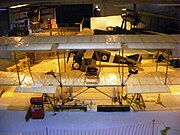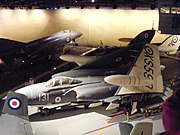| ||||||||||||||||
The Fleet Air Arm Museum is devoted to the history of British naval aviation. It has an extensive collection of military and civilian aircraft, aero engines, models of aircraft and Royal Navy ships (especially aircraft carriers), and paintings and drawings related to naval aviation. It is located on RNAS Yeovilton airfield, and the museum has viewing areas where visitors can watch military aircraft (especially helicopters) take off and land. It is located 7 miles (11 km) north of Yeovil, and 40 miles (64 km) south of Bristol.
Exhibits[]
The museum's main display is divided into four areas:
Hall 1[]

File:Fleet Air Arm Museum hall 1 undergoing refurbishment, 2008.JPG
Contains a display about the development of naval aviation from the early days of airships and fabric-covered wooden biplanes to modern jet aircraft and helicopters, including the front section of the fuselage of Short 184 8359, built locally by Westland aircraft in Yeovil and flown at the Battle of Jutland in 1916 before being put on display at the Imperial War Museum, where it was damaged during World War II when the museum was hit by a bomb. Displayed in an unrestored condition.
Currently contains the following aircraft:
- Short S.27 (replica). An aircraft similar to this was used to make the first takeoff from a moving ship in 1912.
- Sopwith Pup N6452 (replica).
- Supermarine Walrus L2301, one of the aircraft flown by the Irish Air Corps before being bought back by the Fleet Air Arm after the war for use as a training aircraft.
- Fairey Firefly
- BaE Sea Harrier
- Westland Dragonfly
- Westland Lynx
- Westland Sea King
Hall 2[]

Fairey Albacore (N4389)
Mainly devoted to World War II, with a side room containing a Kamikaze exhibit, which contains an Ohka (Yokosuka MXY-7 Ohka II (BAPC 58)), models of Japanese aircraft and final letters from Kamikaze pilots. Two aircraft fom the Korean War are also displayed.. By the entrance to Hall 3 there is a collection of models of British aircraft carriers, illustrating the history of aircraft carrier design. The aircraft on display include:
- Fairey Albacore N4389:British biplane torpedo bomber/reconnaisance aircraft. Made from parts of two aircraft N4389 and N4172.[1]
- Fairey Fulmar N1854: Two-seat fighter. This is the Fulmar prototype, the only surviving example out of the 800 built [2]
- North American Harvard (T-6 Texan): EX976: American trainer.
- Grumman Hellcat American single seat fighterKE209
- Supermarine Seafire F17 SX137: Naval version of the Supermarine Spitfire
- Hawker Sea Fury FB11 Post-war single-seat piston engined fighter WJ231
- Grumman Avenger XB446: American torpedo bomber/reconaissenceXB446
- F4U Corsair KD431: this has had subsequent repaints removed to expose the original 1944 finish.[3]
- Yokosuka MXY-7 Ohka II BAPC 58 Japanese Kamikaze aircraft designed to be carried to its target by a converted medium bomber.
- Mig 15 Russian jet fighter.
Hall 3[]

Simulation of the HMS Ark Royal Flight Deck
Instead of a traditional museum hall, the whole hall has been converted into a mock-up of the fleet carrier HMS Ark Royal as it would have appeared in the 1970s. The entrance to this hall is by a simulated helicopter ride from Hall 2. The hall itself is a simulation of a section of the flight deck of HMS Ark Royal and aircraft are displayed as if they are on the deck. Two large screens show the takeoff and landing of aircraft such as Blackburn Buccaneers and F4 Phantoms. There is also a series of rooms simulating the carrier's island. The aircraft include:
- Fairey Gannet AEW3 (XL503/070/3)
- Vickers Supermarine Scimitar F1 (XD317/112/R)
- De Havilland Sea Vixen FAW2 (XS590/131/E)
- Vickers Supermarine Attacker F1 (WA473/102/J)
- De Havilland Sea Vampire: the third prototype
Hall 4[]

Hall 4 showing Concorde 002, Bristol Scout, BAC 221 and Hawker Hunter T8M
It was flown to Yeovilton on March 1976 and opened to the public in July of that year. It has been on display ever since.[4]
The aircraft on display as of November 2013:
- BAC Concorde G-BSST The second Concorde to fly and the first British built example.
- Handley Page HP.115 XP980: built to explore the performance of low a delta wings at low speeds.
- BAC 221|Fairey Delta 2]] WG774:. Also built as part of the Concorde programme, to explore the ogee-ogive wing planform.
- Hawker Siddeley P.1127, built as part of the development process that led to the Hawker Siddeley Harriern and Sea Harrier.
- Sea Harrier FRS1
- Westland Wyvern TR1 VR137
- Hawker Hunter T8M
- Bristol Scout D N5419 (replica) : Displayed without any of the fabric covering
Other displays[]
In addition to the four main exhibition halls, there are a number of smaller displays. These include:
- A section devoted to the Taranto raid, the Fleet Air Arm's most celebrated exploit in World War 2. The display includes a Fairey Swordfish, which can also be seen from the link between halls 1 and 2.
- The "Merlin Experience", which explains modern anti-submarine techniques.
Reserve Collection[]
The museums collection includes a number of aircraft which are currently being restored and are not on display, although public access is allowed at least once a year. These are housed in Cobham Hall, a climate controlled building across the road from the museum. Aircraft include:
Engines on display[]

Clerget 9B rotary engine on display
The museum possesses a number of aero engines located throughout the halls.
- Alvis Leonides
- Armstrong Siddeley Cheetah
- Bristol Centaurus
- Bristol Mercury
- Bristol Siddeley BS100
- Clerget 9B
- Bristol Siddeley Pegasus
- de Havilland Gipsy Major
- de Havilland Gipsy Queen
- Rolls-Royce Avon
- Rolls-Royce Nene
- Rolls-Royce Merlin
- Rolls-Royce/Snecma Olympus 593
- Sunbeam Gurkha
- Wright R-1820
Other activities[]
Restoration[]
The museum also carries out various restoration projects. the last project was a Corsair KD 431 which in the summer of 2006 was unveiled as it would have appeared in 1944. Visitors can see into (but not enter) the restoration workshop between Hall 3 and Hall 4.
Archives[]
The Fleet Air Arm Museum is the home to an archive of material related to naval aviation.
Visitor facilities[]
The museum's shop is one has the most extensive selections of naval merchandise in the area. The selection includes various themed books and documentaries such as Sailor.
There is an outside adventure playground for children in the museum's grounds, as well as two cafés.
[]
- Aeronauticum, German naval aviation museum, Nordholz
- Fleet Air Arm Museum (Australia), Australian museum of naval aviaiton, Nowra, New South Wales
- National Naval Aviation Museum, United States museum of naval aviation, Naval Air Station Pensacola, Florida
- Naval Aviation Museum (India), Indian naval aviation museum, Goa, India
- Shearwater Aviation Museum, Canadian naval aviation museum, Sheerwater, Nova Scotia.
Other[]
- List of aerospace museums
- List of museums in Somerset
References[]
- ↑ "Fairey Albacore N4389". Fleet Air Arm Museum. http://www.fleetairarm.com/exhibits/planes.asp?plane=60. Retrieved 2008-12-31.
- ↑ Mason, Francis K. The British Bomber Since 1914. London: Putnam Aeronautical Books, 1994. ISBN 0-85177-861-5.
- ↑ "Corsair KD 431 - A Ground Breaking Project". Fleet Air Arm Museum. http://www.fleetairarm.com/exhibits/planes.asp?plane=153. Retrieved 2008-12-31.
- ↑ "BAC Concorde". Fleet Air Arm Museum. http://www.fleetairarm.com/exhibits/planes.asp?plane=87. Retrieved 2008-12-31.
External links[]
| Wikimedia Commons has media related to Fleet Air Arm Museum. |
The original article can be found at Fleet Air Arm Museum and the edit history here.

